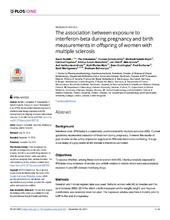| dc.contributor.author | Burkill, Sarah | en_US |
| dc.contributor.author | Vattulainen, Pia | en_US |
| dc.contributor.author | Geissbuehler, Yvonne | en_US |
| dc.contributor.author | Sabido Espin, Meritxell | en_US |
| dc.contributor.author | Popescu, Catrinel | en_US |
| dc.contributor.author | Suzart-Woischnik, Kiliana | en_US |
| dc.contributor.author | Hillert, Jan | en_US |
| dc.contributor.author | Artama, Miia | en_US |
| dc.contributor.author | Verkkoniemi-Ahola, Auli | en_US |
| dc.contributor.author | Myhr, Kjell-Morten | en_US |
| dc.contributor.author | Cnattingius, Sven | en_US |
| dc.contributor.author | Korhonen, Pasi | en_US |
| dc.contributor.author | Montgomery, Scott | en_US |
| dc.contributor.author | Bahmanyar, Shahram | en_US |
| dc.date.accessioned | 2020-05-28T17:04:57Z | |
| dc.date.available | 2020-05-28T17:04:57Z | |
| dc.date.issued | 2019-12-30 | |
| dc.Published | Burkill S, Vattulainen P, Geissbuehler Y, Sabido Espin M, et al. The Association Between Exposure to Interferon-Beta During Pregnancy and Birth Measurements in Offspring of Women With Multiple Sclerosis. PLOS ONE. 2019;14(12): e0227120 | eng |
| dc.identifier.issn | 1932-6203 | |
| dc.identifier.uri | https://hdl.handle.net/1956/22407 | |
| dc.description.abstract | Background: Interferon-beta (IFN-beta) is a commonly used treatment for multiple sclerosis (MS). Current guidelines recommend cessation of treatment during pregnancy, however the results of past studies on the safety of prenatal exposure to IFN-beta have been conflicting. A large scale study of a population of MS women is therefore warranted. Objectives: To assess whether, among those born to women with MS, infants prenatally exposed to IFN-beta show evidence of smaller size at birth relative to infants which were not prenatally exposed to any MS disease modifying drugs. Methods: Swedish and Finnish register data was used. Births to women with MS in Sweden and Finland between 2005–2014 for which a birth measurement for weight, height, and head circumference was available were included. The exposure window was from 6 months prior to LMP to the end of pregnancy. Results: In Sweden, 411 pregnancies were identified as exposed to IFN-beta during the exposure window, and 835 pregnancies were counted as unexposed to any MS DMD. The corresponding numbers for Finland were 232 and 331 respectively. Infants prenatally exposed to interferon-beta were on average 28 grams heavier (p = 0.17), 0.01 cm longer (p = 0.95), and had head circumferences 0.14 cm larger (p = 0.13) in Sweden. In Finland, infants were 50 grams lighter (p = 0.27), 0.02 cm shorter (p = 0.92) and had head circumferences 0.22 cm smaller (p = 0.15) relative to those unexposed. Conclusions: This study provides evidence that exposure to IFN-beta during pregnancy does not influence birth weight, length, or head circumference. | en_US |
| dc.language.iso | eng | eng |
| dc.publisher | Public Library of Science | eng |
| dc.rights | Attribution CC BY | eng |
| dc.rights.uri | http://creativecommons.org/licenses/by/4.0/ | eng |
| dc.title | The Association Between Exposure to Interferon-Beta During Pregnancy and Birth Measurements in Offspring of Women With Multiple Sclerosis | en_US |
| dc.type | Peer reviewed | |
| dc.type | Journal article | |
| dc.date.updated | 2020-01-21T07:39:26Z | |
| dc.description.version | publishedVersion | en_US |
| dc.rights.holder | Copyright 2019 The Author(s) | |
| dc.identifier.doi | https://doi.org/10.1371/journal.pone.0227120 | |
| dc.identifier.cristin | 1778838 | |
| dc.source.journal | PLoS ONE | |

